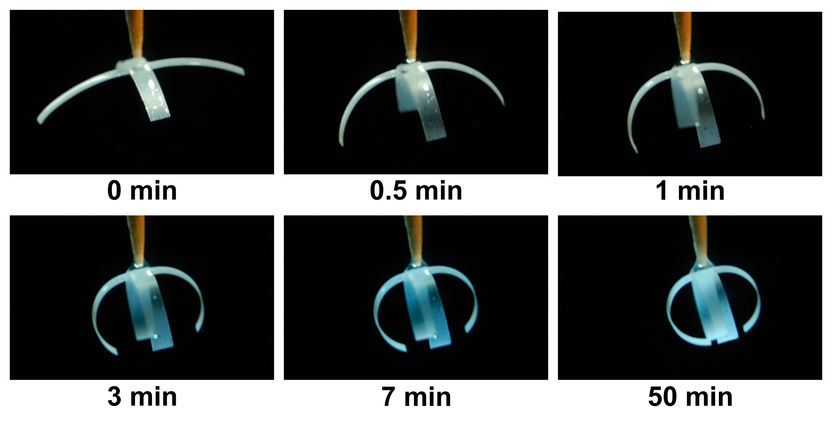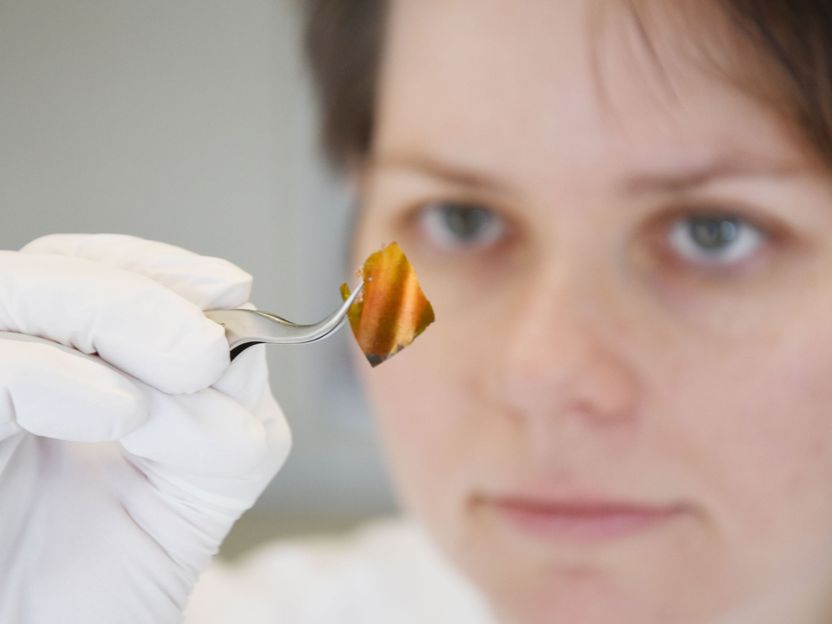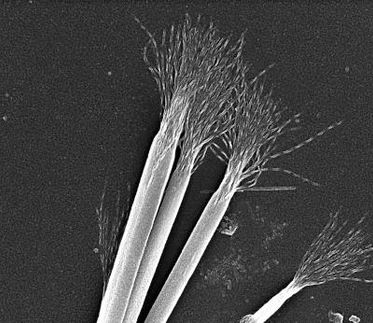Scotch tape finds new use as grasping 'smart material'
Scotch tape, a versatile household staple and a mainstay of holiday gift-wrapping, may have a new scientific application as a shape-changing "smart material."

The researchers used Scotch tape to create a tiny grasping claw that collects droplets of water, an innovation could be used to collect water samples for environmental testing. The material, seen here, becomes flexible when exposed to humidity and returns to its original shape when dry.
Foto: M. Ochoa, Purdue University
Researchers used a laser to form slender half-centimeter-long fingers out of the tape. When exposed to water, the four wispy fingers morph into a tiny robotic claw that captures water droplets.
The innovation could be used to collect water samples for environmental testing, saidBabak Ziaie, a Purdue University professor of electrical and computer engineering and biomedical engineering.
The Scotch tape - made from a cellulose-acetate sheet and an adhesive - is uniquely suited for the purpose.
"It can be micromachined into different shapes and works as an inexpensive smart material that interacts with its environment to perform specific functions," he said.
Doctoral student Manuel Ochoa came up with the idea. While using tape to collect pollen, he noticed that it curled when exposed to humidity. The cellulose-acetate absorbs water, but the adhesive film repels water.
"So, when one side absorbs water it expands, the other side stays the same, causing it to curl," Ziaie said.
A laser was used to machine the tape to a tenth of its original thickness, enhancing this curling action. The researchers coated the graspers with magnetic nanoparticles so that they could be collected with a magnet.
"Say you were sampling for certain bacteria in water," Ziaie said. "You could drop a bunch of these and then come the next day and collect them.”
Findings will be detailed in a presentation during a meeting of the Materials Research Society in Boston from Sunday (Nov. 25) to Nov. 30. Experiments at Purdue'sBirck Nanotechnology Centerwere conducted by Ochoa, doctoral student Girish Chitnis and Ziaie.
The grippers close underwater within minutes and can sample one-tenth of a milliliter of liquid.
The materials might be "functionalized" so that they attract specific biochemicals or bacteria in water.
"Although brittle when dry, the material becomes flexible when immersed in water and is restored to its original shape upon drying, a crucial requirement for an actuator material because you can use it over and over," Ziaie said. "Various microstructures can be carved out of the tape by using laser machining. This fabrication method offers the capabilities of rapid prototyping and batch processing without the need for complex clean-room processes."
Topics
Organizations
Other news from the department science

Get the chemical industry in your inbox
By submitting this form you agree that LUMITOS AG will send you the newsletter(s) selected above by email. Your data will not be passed on to third parties. Your data will be stored and processed in accordance with our data protection regulations. LUMITOS may contact you by email for the purpose of advertising or market and opinion surveys. You can revoke your consent at any time without giving reasons to LUMITOS AG, Ernst-Augustin-Str. 2, 12489 Berlin, Germany or by e-mail at revoke@lumitos.com with effect for the future. In addition, each email contains a link to unsubscribe from the corresponding newsletter.
Most read news
More news from our other portals
Last viewed contents
Two in one solution for low cost polymer LEDs and solar cells
Angiotensin_receptor
Asbestos,_Quebec

High-performance combination: Batteries made of silicon and sulphur - Research team of material scientists present an innovative, sustainable energy storage concept

We Wouldn’t Be Able to Control Superintelligent Machines - Would the AI cure cancer, bring about world peace, and prevent a climate disaster? Or would it destroy humanity and take over the Earth?
LyondellBasell to Close LDPE Unit at Carrington, U.K.

Rudolph Logic Systems GmbH - Sarstedt, Germany

Challenging counterfeit products with rare earths - New marking technique could halt product piracy
Merck KGaA and Nano-Terra Announce Extension of Nanotechnology Solutions Alliance





























































